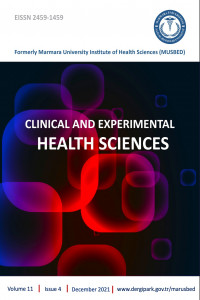Abstract
References
- İlt__clinical_and_experimetal_health_sciences/BELGE (3).pdf
Abstract
Objective: COVID-19 pandemic affect dental education as well as everything. Online education become more popular in dentistry nowadays. It was aimed to evaluate the effectiveness of online lessons and satisfaction of the students about distance learning.
Methods: It was asked to respond a 42-items questionnaire at University of Uşak, School of Dentistry. Seven questions were related to demographic data. Thirty-two lickert and three multiple choice questions to determine the quality of current non-clinical and clinical education and to form a guide for future online dental education. The answers were analyzed on IBM SPSS Statistics for Windows, version 22.0 (IBM Corp, Armonk, NY, USA).
Results: This study aimed to reach 316 dental students, of which 302(95.5%) responded (Cronbach Alfa= 0.964). Factor analysis was performed to check the suitability of the data. The Kaiser-Meyer-Olkin measure of sampling adequacy was 0.961 and Barlett’s test of sphericity was significant(p < 0.001). Male students more pleased than female students in term of distance learning(p=0.032). Foreign students felt more comfortable participating actively in online lessons than face-to-face(p=0.047). Fourth grade students were significantly pleased distance learning than first and second grades students(p<0.05). Most of the students would prefer blended education(65.2%). 84,4% of the students declared that it is difficult to put into practice that has been learned and 65,9% of them thought that their professional education was interrupted.
Conclusions: Online clinical-based lessons were more difficult to understand for the students. It can be concluded that blended education will be a good alternative system for future dental education.
References
- İlt__clinical_and_experimetal_health_sciences/BELGE (3).pdf
Details
| Primary Language | English |
|---|---|
| Subjects | Health Care Administration |
| Journal Section | Articles |
| Authors | |
| Publication Date | October 26, 2021 |
| Submission Date | April 14, 2021 |
| Published in Issue | Year 2021 Volume: 11 Issue: 4 |


